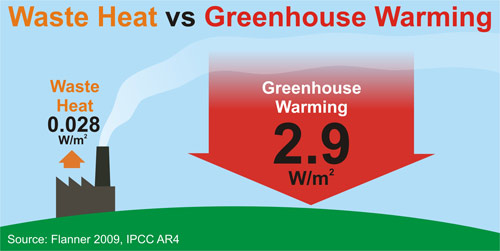Waste heat vs greenhouse warming
Posted on 27 July 2010 by John Cook
A vigorous discussion has erupted on the waste heat page. Problem is, there's not meant to be a waste heat page! As I encounter new skeptic arguments, I add them to the to-do list and gradually (very gradually) research the peer-reviewed literature then write an explanation of what the science says, usually in order of popularity. I hadn't got around to looking into the issue of waste heat. Nevertheless, one intrepid Skeptical Science user found the empty page waiting to be populated and began a discussion there (j'accuse Doug Bostrom). So let's look at waste heat...
Firstly, what is waste heat? When humans use energy, it gives off heat. Whenever we burn fossil fuels, heat is emitted. This heat doesn't just disappear - it dissipates into our environment. How much does waste heat contribute to global warming? This has been calculated in Flanner 2009 (if you want to read the full paper, access details are posted here). Flanner contributes that the contribution of waste heat to the global climate is 0.028 W/m2. In contrast, the contribution from human greenhouse gases is 2.9 W/m2 (IPCC AR4 Section 2.1). Waste heat is about 1% of greenhouse warming.

What do these numbers mean? They refer to radiative forcing, the change in energy flux at the top of the atmosphere. Or putting it in plain English, the amount of heat being added to our climate. Greenhouse warming is currently adding about 100 times more heat to our climate than waste heat.
UPDATE 27 July: there is some confusion about the term 'waste heat'. Here, what I'm talking about is all the heat generated by energy use. When humans generate energy, much of it is immediately dissipated as heat. The rest is converted to electricity or energy of some sort (eg - mechanical, chemical, etc). But even this energy eventually dissipates as heat into the environment. So yes, 'waste heat' is not an ideal term. Flanner uses the term "anthropogenic heat flux".































 Arguments
Arguments























 0
0  0
0










Comments